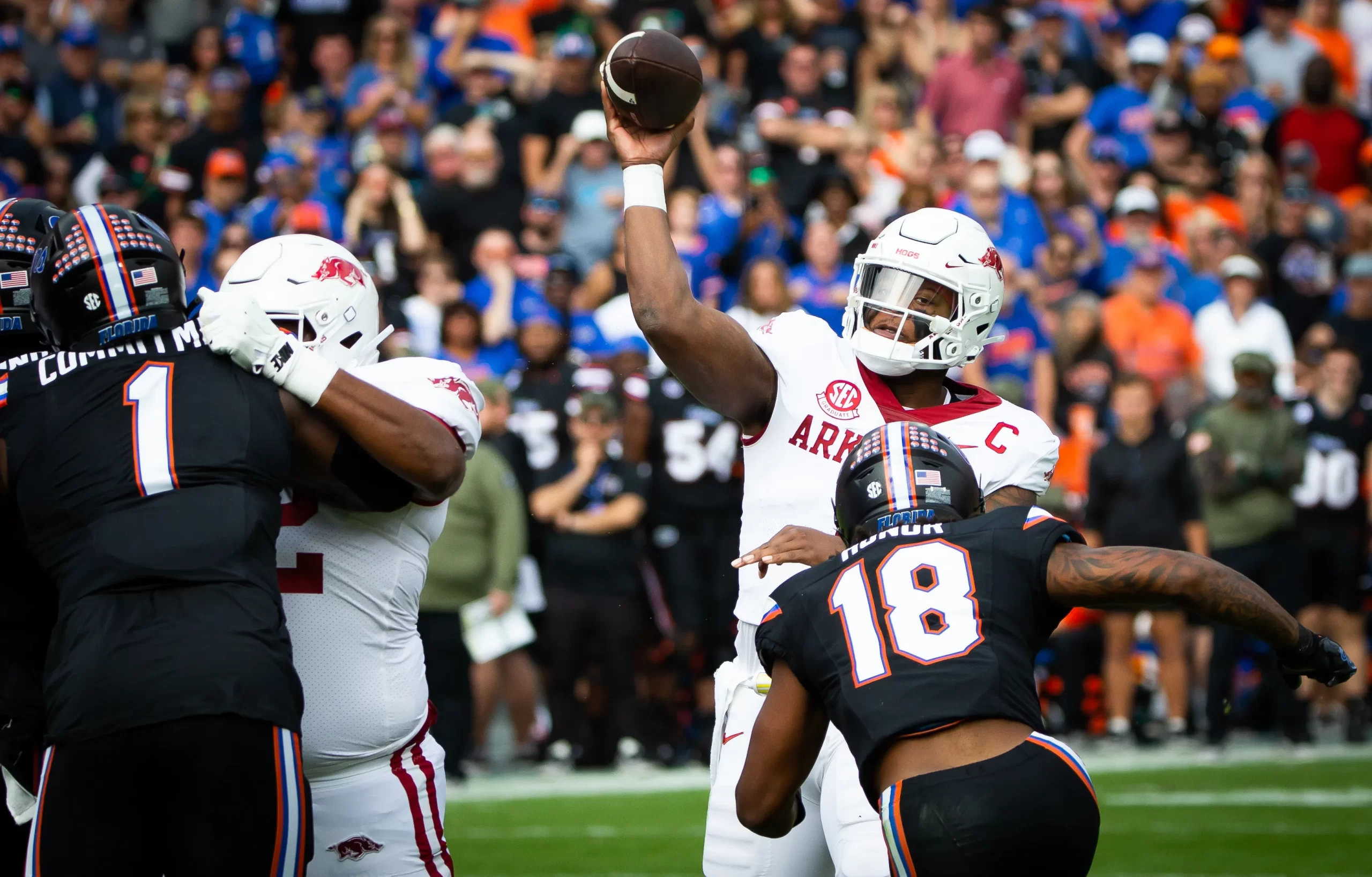Arkansas’ bowl hopes remain alive after a thrilling 39-36 win over Florida. This win was everything that Hog fans (and Sam Pittman) needed to keep hope alive. There’s still a lot of work to be done, as the Hogs are just 3-6, and a 4-8 finish would not sit well with many. Still, the Hogs have their first-ever win in Gainesville and are not going to go winless in SEC play as they did in 2013, 2018, and 2019.
Let’s take a look at the numbers and some big plays. In particular, we’ll see how interim OC Kenny Guiton went right back to what worked under former OC Kendal Briles… and how it paid off.
Advanced Stats
We’re trying something a little different today. The ESPN play-by-play data that we use has been pretty unreliable, and instead of trying to fix it, I’m on to basketball (where we have a direct NCAA API that provides perfectly accurate data). However, the awesome data team that built the connection to ESPN that we use for our football data also designed a really cool website, gameonpaper.com, that uses the same stats we use, but with much cooler visuals. We’ll be screen-shotting in this post, but please visit their site if you’re interested in even more stats. They’re provided an inspiration of where we’d like to get our data visualizations in the future!

This was a strong offensive game for both teams. The Hogs still weren’t overly explosive, but the explosive plays they did have were more impactful that Florida’s. The Hogs had completed passes of 48 and 45, plus rushes of 20 and 25. Both of those big passes came on third down to Andrew Armstrong.

Some early punt coverage issues plus a turnover in minus territory meant that Arkansas had to gain a lot more yards just to keep this thing close. The Hogs ended up gaining 61% of available yards, which is really good.

I really want to highlight the rushing numbers, because Arkansas churned out 253 non-sack rushing yards in this game. The two numbers I’ve highlighted are important: half of Arkansas’ non-sack runs gained at least four yards (“opportunity runs”), and only two failed to gain anything (“stuffed runs”). That “highlight yards” stat at the very bottom is yards gained beyond four on opportunity runs. The Hogs only got 4.7 highlight yards per opportunity, which means their 20 best runs averaged just 8.7 yards per rush. That isn’t amazing, but the quantity of good runs meant that the Hogs delivered 93 highlight yards. That’s the second-most in a game this year, and the BYU game only featured more because AJ Green’s big touchdown had 61 on one play.
Basically, Arkansas really got going downhill and forced Florida to respect the run. That’s how the downfield pass game was able to be a threat.
We’ll revisit the run game in a second, but here’s KJ’s pass chart:
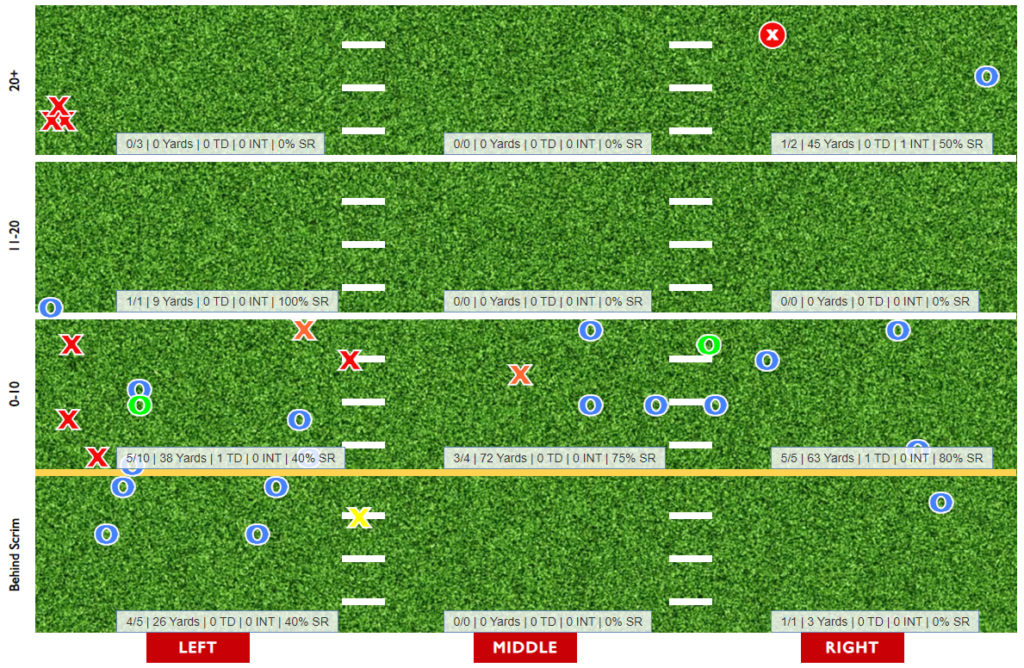
This pass chart under Guiton looks a bit different than the ones under Dan Enos. First, only six throws were targeted behind the line of scrimmage, with Jefferson finishing 5 of 6 for 29 yards. Against Mississippi State, Jefferson was 9 of 9 for 10 yards (!) on such throws. So Arkansas’ screens were slightly fewer and slightly more productive in this game.
So where did those screens go? Inside the hashmarks. Against State, Jefferson was 1 of 2 for 9 yards and a pick on throws inside the hashes. Yes, he attempted just two passes inside the hash. In this game, he was 3 of 4 for 72 yards with three other throws near the middle of the field. Those screens did not become deep throws: Jefferson was 2 of 6 for 54 yards and a pick on throws of 10+ air yards.
The one worth noting was the 45-yard pass to Andrew Armstrong, which came on a classic Briles solo shot concept. It’s always play-action (or an RPO), targeting a solo deep route on one side with some kind of vertical route combo on the backside to lure the safeties away:
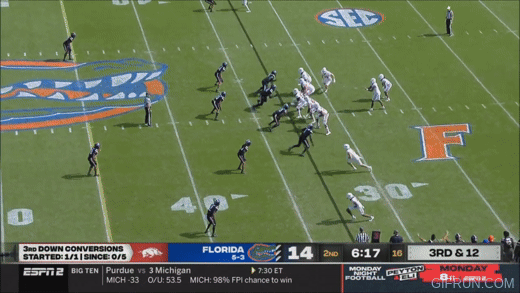
Look familiar? Maybe you’ll recognize this one:
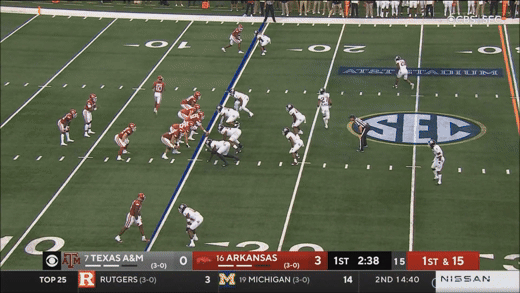
Despite the lack of deep passes (outside of that one), you probably noticed was that Arkansas receivers looked much more open on those underneath throws. How’s that possible? One of Arkansas’ biggest personnel weaknesses is that its receivers struggle to get separation.
The way Arkansas did it was established on the game’s very first play:
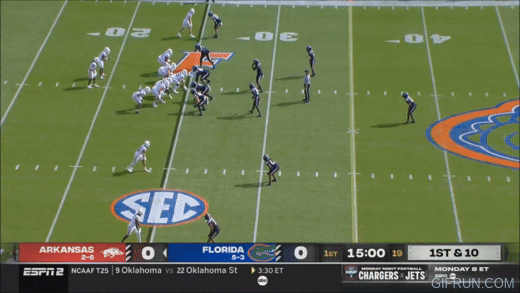
This was a tricky play, but watch Florida’s three linebackers. The Hogs got them moving east and west from the opening snap. This is classic spread football, where you make the defense cover the entire field from sideline to sideline.
This takes us back to the run game, where the Hogs went right back to the Kendal Briles offense, dialing up a season-high 14 outside zones to punish Florida’s edge.
Again, watch the linebackers have to flow east and west:
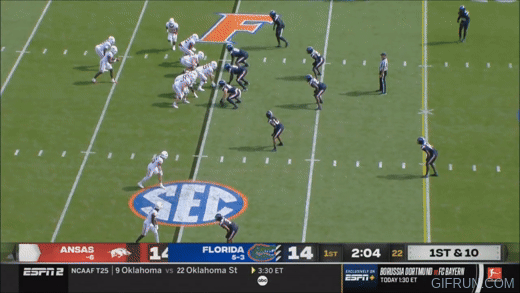
The nice thing about outside zone is when you have a back like Rocket Sanders, he can see the built-in cutback lane when the primary run direction is cut off:
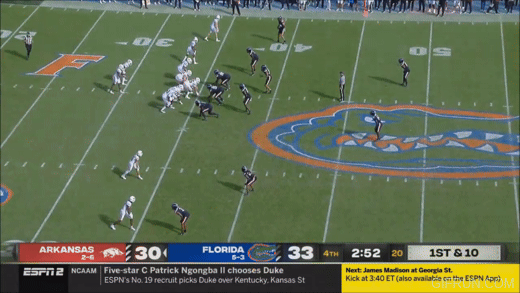
If this run looks familiar, it’s because that was also Sanders’ first big run as a Hog, in the 2021 Texas game:
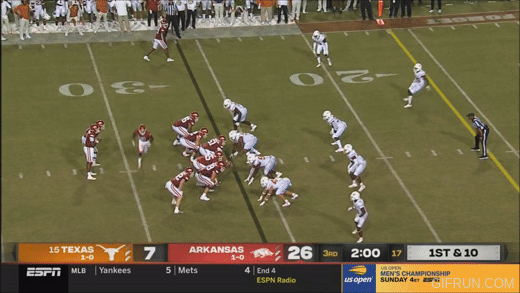
Arkansas’ outside zones totaled 14 carries for 90 yards with seven successes (50%). It was easily their best concept of the game. Unlike Briles, Enos didn’t run a ton of outside zone; it made up less than 30% of Arkansas’ run calls, but was at almost 40% in this game.
Outside zone complements the pocket-rolling and underneath routes because it keeps those linebackers having move east to west, but it also sets you up to run straight downhill when the time is right. That was Guiton’s best playcall of the whole game. On 1st-and-20 in overtime, after the Hogs have run 14 outside zones and moved the linebackers horizontally all game, Guiton dials up a run that looks like outside zone but is in fact a straight downhill run: Power Veer. This was Arkansas’ only Power Veer of the game:
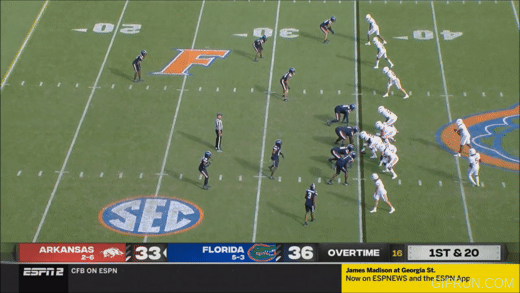
Look at how far Florida’s linebackers ran themselves out of the play. The Hogs had them on rollerskates in the fourth quarter and overtime. That’s a really impressive example of Guiton using base plays to set up the complementary plays. For a first-time playcaller, he gets an A+ grade for both gameplan and playcalling.
So, is it time to overreact? The Hogs are winning out? Let’s not get too far ahead of ourselves. As we’ve already noted, Florida’s defense was trending in the wrong direction before this game, and Auburn and Mizzou have better defenses.
Additionally some of the underlying numbers are somewhat less optimistic. Basically, Arkansas’ rushing success appears to be largely the product of a Herculean effort by Jefferson and Sanders. Per SEC StatCat, the Hogs averaged a subpar 1.1 yards before contact per rush. While only two non-sack runs went backward, the Hogs had 11 runs where the runner was first contacted behind the line of scrimmage, but managed to create a positive gain (SEC StatCat calls these “gumption runs”). The Hogs broke 20 tackles in the run game alone. Even if you remove Jefferson’s runs (most of his feature nothing before contact), Jefferson and Sanders combined for 1.6 yards before contact per rush, merely in line with the SEC average of 1.7.
The takeaway is that breaking 20 tackles a game with 11 gumption runs a game is probably not sustainable, especially against better defenses. So while I think that Arkansas had a great plan and executed it well, there are still some deficiencies that could show up in these last few games. Nevertheless, the confidence for the offense has to be high right now. We’ll see what they can do against a tougher Auburn defense next week.
Thanks for reading! Be sure to follow us on Twitter and on Facebook.
The latest from Fayette Villains, straight to your inbox
Enter your email to subscribe and receive new post alerts and other updates. You can unsubscribe at any time.
